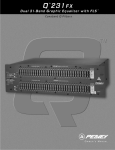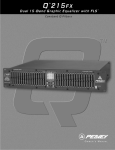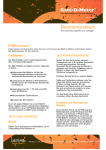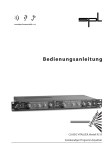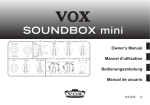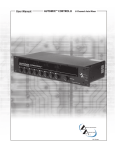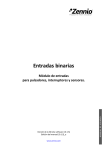Download Peavey Q431FX User's Manual
Transcript
™ Q 431FX 3 1- B a n d G r a p h i c E q u a l i z e r w i t h F L S ® Constant Q Filters OWNER’S MANUAL Intended to alert the user to the presence of uninsulated "dangerous voltage" within the product's enclosure that may be of sufficient magnitude to constitute a risk of electric shock to persons. Intended to alert the user of the presence of important operating and maintenance (servicing) instructions in the literature accompanying the product. CAUTION: Risk of electrical shock – DO NOT OPEN! CAUTION: To reduce the risk of electric shock, do not remove cover. No user serviceable parts inside. Refer servicing to qualified service personnel. WARNING: To prevent electrical shock or fire hazard, do not expose this appliance to rain or moisture. Before using this appliance, read the operating guide for further warnings. Este símbolo tiene el propósito de alertar al usuario de la presencia de "(voltaje) peligroso" que no tiene aislamiento dentro de la caja del producto que puede tener una magnitud suficiente como para constituir riesgo de corrientazo. Este símbolo tiene el propósito de alertar al usario de la presencia de instruccones importantes sobre la operación y mantenimiento en la literatura que viene con el producto. PRECAUCION: Riesgo de corrientazo – No abra. PRECAUCION: Para disminuír el riesgo de corrientazo, no abra la cubierta. No hay piezas adentro que el usario pueda reparar. Deje todo mantenimiento a los técnicos calificados. ADVERTENCIA: Para evitar corrientazos o peligro de incendio, no deje expuesto a la lluvia o humedad este aparato Antes de usar este aparato, lea más advertencias en la guía de operación. Ce symbole est utilisé pur indiquer à l'utilisateur la présence à l'intérieur de ce produit de tension non-isolée dangereuse pouvant être d'intensité suffisante pour constituer un risque de choc électrique. Ce symbole est utilisé pour indiquer à l'utilisateur qu'il ou qu'elle trouvera d'importantes instructions sur l'utilisation et l'entretien (service) de l'appareil dans la littérature accompagnant le produit. ATTENTION: Risques de choc électrique – NE PAS OUVRIR! ATTENTION: Afin de réduire le risque de choc électrique, ne pas enlever le couvercle. Il ne se trouve à l'intérieur aucune pièce pouvant être réparée par l'utilisateur. Confier l'entretien à un personnel qualifié. AVERTISSEMENT: Afin de prévenir les risques de décharge électrique ou de feu, n'exposez pas cet appareil à la pluie ou à l'humidité. Avant d'utiliser cet appareil, lisez les avertissements supplémentaires situés dans le guide. Dieses Symbol soll den Anwender vor unisolierten gefährlichen Spannungen innerhalb des Gehäuses warnen, die von Ausreichender Stärke sind, um einen elektrischen Schlag verursachen zu können. Dieses Symbol soll den Benutzer auf wichtige Instruktionen in der Bedienungsanleitung aufmerksam machen, die Handhabung und Wartung des Produkts betreffen. VORSICHT: Risiko – Elektrischer Schlag! Nicht öffnen! VORSICHT: Um das Risiko eines elektrischen Schlages zu vermeiden, nicht die Abdeckung enfernen. Es befinden sich keine Teile darin, die vom Anwender repariert werden könnten. Reparaturen nur von qualifiziertem Fachpersonal durchführen lassen. ACHTUNG: Um einen elektrischen Schlag oder Feuergefahr zu vermeiden, sollte dieses Gerät nicht dem Regen oder Feuchtigkeit ausgesetzt werden. Vor Inbetriebnahme unbedingt die Bedienungsanleitung lesen. 2 E N G L I S H 6 1 8 7 2 4 3 5 9 Congratulations on purchasing the Q431FX! Peavey engineers have taken Graphic Equalizers to the next level with its introduction. We trust that you are eager to place this unit into YOUR system ASAP. The Q431FX offers 31 bands of 1/3 octave filters featuring superior constant “Q” devices. LED indicators are located above the frequency bands to identify the presence of a high energy signal (usually feedback). This sophisticated feedback detector system will allow you to quickly identify and remove feedback. It works like this: when the feedback detection circuit detects the frequency band with the most energy, it causes the LED above the associated frequency band to illuminate. By moving the fader downward for that band, the likelihood of feedback is reduced/eliminated. Most use the Q431FX in one of two ways: 1. To catch and reduce/eliminate feedback “on-the-fly” during a performance. 2. To determine frequency bands that are susceptible to feedback BEFORE the performance, eliminating them in advance. How do you do this? After the system is set up, slowly bring up the microphone levels. As they start to feeback, note the LED activity on the Q431FX feedback bands. Move the faders to decrease the “identified” bands. Now you have eliminated a high percentage of potential feedback problems before the performance even begins! NOTE: It is not uncommon for feedback to be active over several frequency bands. Also, go easy when making fader adjustments since extreme movements will affect your performance and be counter productive. If any operational questions come up, be sure and contact our Customer Service department at (601) 483-5365. Thanks for supporting Peavey! OPERATION NOTE This equalizer is designed to provide room equalization, feedback control, and system tone control. No amount of equalization will correct an acoustically bad room/mic/speaker arrangement or completely correct the response curve of a poor loudspeaker. Always begin with all sliders in the “0” position and avoid excessively cutting large segments of the audio passband, as this will limit the system’s dynamic range. Exercise caution when attempting to boost equalization below cutoff of the speaker system. Typical sound reinforcement enclosures are not designed for 20 Hz performance and transducer damage could result. 3 LOW CUT (1) Provides high pass filtering at 40 Hz in the “in” position. Low frequency roll off is at 12 dB per octave. LOW CUT LED (2) With the low cut switch in the “in” position, this LED will illuminate indicating a low frequency roll off at 12 dB per octave at 40 Hz. BYPASS (3) In bypass mode (switch in), the input signal is routed directly to the output and is unaffected by all front panel controls with the exception of the low cut filter. BYPASS LED (4) This LED will illuminate when the bypass switch is in the “in” position indicating that the EQ and gain controls are bypassed. EQUALIZER SECTION (5) 31-bands of 1/3 octave filters. The filters are constant “Q” devices located at ISO center frequencies. Effective equalization range is from 20 Hz to 20 kHz. Maximum cut per frequency is 18dB and the maximum boost per frequency is 12 dB. AUTOMATIC FEEDBACK LOCATING LEDs (6) When feedback occurs, the LED of the frequency band that is feeding back will illuminate over the slider that needs adjusting. The LED will remain illuminated for a few seconds even after the feedback is gone. This allows you to see where the feedback is if the feedback goes away before any correction is made. If there is no feedback occurring, all the LEDs will become active, acting as a basic real-time analyzer. LED LEVEL METER (7) This multicolored LED ladder indicates output level. GAIN (8) Calibrated control for regulating overall gain of an equalizer section. Unity gain throughout the signal chain may be maintained by recovering lost signal at this point. Example: Assume the equalization process has introduced a signal loss of -6dB by negative (-) adjustment of the EQ section. The gain should be adjusted to +6dB to maintain unity gain through the equalizer. POWER SWITCH (9) Used to turn AC mains power on or off. 4 Back Panel: 11 10 12 13 14 BACK PANEL FEATURES: LINE CORD-120V PRODUCTS ONLY (10) We have incorporated a 2-wire line (mains) cable for power on the Q431 FX. Power requirements: Domestic: 120 V AC / 60 Hz / 20 W. NOTE: CAUTION: TO PREVENT ELECTRIC SHOCK, MATCH WIDE BLADE OF PLUG TO WIDE SLOT, FULLY INSERT. Export: 230 V AC / 50/60 Hz / 20 W. NOTE: FOR UK ONLY As the colors of the wires in the mains lead of this apparatus may not correspond with the colored markings identifying the terminals in your plug, proceed as follows: (1) The wire which is colored green and yellow must be connected to the terminal which is marked by the letter E or by the earth symbol or colored green or green and yellow. (2) The wire which is colored blue must be connected to the terminal which is marked with the letter N or the color black. (3) The wire which is colored brown must be connected to the terminal which is marked with the letter L or color red. 1/4" OUTPUT (11) A 1/4" Tip-Ring-Sleeve (stereo) jack provides balanced inputs when used with stereo (TRS) 1/4" plugs and 2-conductor shielded cables. When used with a mono 1/4" phone plug, the output is unbalanced. XLR OUTPUTS (12) This XLR jack provides an electronically balanced output that is electrically the same as the 1/4" TRS Output (11). Using this balanced output will provide a 6 dB increase from unbalanced operation. 1/4" INPUT (13) A 1/4" Tip-Ring-Sleeve (stereo) jack provides balanced inputs when used with stereo (TRS) 1/4" plugs and 2-conductor shielded cables. When used with a mono 1/4" phone plug, the input is unbalanced. XLR INPUTS (14) This XLR jack provides a balanced input that is electrically the same as the 1/4" TRS Input (13). 5 Q™ 431FX SPECIFICATIONS All specifications are typical unless otherwise noted. 0 dBV = 1 Volt All specifications are referenced to nominal output level (0 dBV) unless otherwise stated. All measurements are wide band 20 Hz to 20 kHz unless otherwise stated. NOTE: All specifications measured at 1 V RMS input and unbalanced output. All sliders at mid position; all switches out unless otherwise noted. Frequency Response: ±1 dB, 20 Hz to 20 kHz Distortion: .005%, 20 Hz to 20 kHz Input Impedance: Balanced 20 K ohms (equal impedances to ground) Output Impedance: 330 ohms Maximum Input Level: +18 dBV (8 VRMS) Maximum Output Level: +18 dBV (8 VRMS) Nominal Input Level: 0 dBV (1 VRMS) Nominal Output Level: 0 dBV (1 VRMS) Input Headroom: Nominal 18 dB Output Headroom: 18 dB Output Noise: EQ in bypass: -101 dBV EQ in filter: -95 dBV Filter Frequencies: 20, 25, 32, 40, 50, 63, 80, 100, 125, 160, 200, 250, 315, 400, 500, 630, 800, 1 K, 1.25 K, 1.6 K, 2 K, 2.5 K, 3.15K, 4 K, 5 K, 6.3 K, 8 K, 10 K, 12.5 K, 16 K, and 20 kHz Filter Q: 4.77 Maximum Boost and Cut Filter: +12 dB,-18 dB Maximum Boost and Cut Gain: ±15 dB Low Cut Filer: 40 Hz Dimensions and Weight: 3.5" H x 19"W x 9.75" D 9.2 lbs. TM ® Due to our efforts for constant improvements, features and specifications listed herein are subject to change without notice. 6 7 XLR INPUT BALANCED INPUT (+/- 15dB) GAIN Locator Feedback 63 Hz 80 Hz 100 Hz 160 Hz Locator 315 Hz Locator Locator Locator 630 Hz Locator 1 kHz Feedback 800 Hz Feedback 500 Hz Feedback Locator Feedback 400 Hz Feedback 250 Hz Feedback 200 Hz Locator Feedback Locator Locator 1.6 kHz LOW CUT OUTPUT EQ BYPASS AMP LED OUTPUT METER Locator Locator XLR OUTPUT Locator Locator Feedback 16 kHz Locator Feedback 12.5 kHz Feedback 10 kHz BALANCED/ UNBALANCED OUTPUT 4 kHz Locator Locator Feedback 8k kHz Feedback 6.3 kHz Feedback Locator Locator Feedback 5 kHz Feedback 3.15 kHz Feedback 2.5 kHz Feedback Locator Locator Feedback 2 kHz Feedback 1.25 kHz Feedback Locator Feedback NOTE: EACH FILTER HAS +12 dB / -18 dB GAIN Locator Locator Feedback 125 Hz Feedback Locator Feedback 40 kHz 20 kHz Locator Feedback Locator Feedback BALANCED INPUT AMP 40 Hz Locator Locator 25 Hz Feedback 50 Hz Feedback 32 Hz Locator Locator 20 Hz Feedback Feedback 1/3 OCTAVE FILTERS This block diagram shows the signal path within the unit. In order to thoroughly understand the unit's functions please study the block diagram carefully. Q™ 431FX BLOCK DIAGRAM E S PA Ñ O L Consulte los diagramas del panel delantero en la sección de inglés de este manual. ¡Felicidades por tu compra del Q431FX! Los ingenieros de Peavey han llevado los ecualizadores gráficos al siguiente nivel y esperan que estés ansioso por poner YA esta unidad en TU sistema. El Q431FX ofrece 31 bandas de filtros de 1/3 de octava que cuentan con dispositivos de constante “Q” superiores. Tiene indicadores LED1 localizados sobre las bandas de frecuencia para identificar la presencia de una señal de alta energía (normalmente retroalimentación). Este sofisticado sistema detector de retroalimentación te permitirá identificar y eliminar rápidamente la retroalimentación. Funciona así: Cuando el circuito detector de retroalimentación detecta la banda de frecuencia con la señal de energía más alta, hace que se ilumine el indicador LED de arriba de la banda asociada de frecuencia. Al mover hacia abajo el atenuador de esa banda de frecuencia, se reduce/elimina la probabilidad de retroalimentación. La mayoría usa el Q431FX de una de dos maneras: 1. Para localizar y eliminar o reducir la retroalimentación “al vuelo” durante una actuación. 2. Para determinar la bandas de frecuencia que son más susceptibles de retroalimentación ANTES de la actuación y eliminarlas por adelantado. ¿Cómo hacer esto? Después de instalar el sistema, se eleva lentamente el nivel de los micrófonos. Al comenzar a retroalimentarse, nota la actividad de los indicadores LED en las bandas del Q431FX que se retroalimentan. Mueve los atenuadores para disminuir las bandas “identificadas.” ¡Ya has eliminado un alto porcentaje de retroalimentación incluso antes de comenzar la actuación! NOTA: No es raro que haya retroalimentación activa sobre varias bandas de frecuencia. Asimismo, ten cuidado al hacer los ajustes de los atenuadores, ya que los movimientos extremos afectarán tu actuación y serán contraproducentes. Si surge alguna pregunta sobre su operación, asegúrate de comunicarte con nuestro depto. de servicio al cliente al 601 483-5365. Muchas gracias por apoyar a Peavey! NOTA: Este ecualizador fue diseñado para proveer ecualización de ambiente, control de realimentación y control de tono del sistema. Ninguna cantidad de ecualización corregirá un arreglo de cuarto/micrófono/ altavoz que esté acusticamente mal, ni tampoco corregirá completamente la curva de respuesta de un altavoz deficiente. Comience siempre con todos los controles deslizables en la posición “O” y evite cortar excesivamente largos segmentos de la banda de audio, cosa que limitaría la gama dinámica del sistema. Prestar atención al intentar aumentar la igualación por debajo del punto de corte del sistema de altavoces. Los refuerzos típicos de las cajas de altavoces no están diseñados para una potencia de 20 Hz y podrían dañarse los transductores. 8 LOW CUT (Corte inferior) (1) Cuando se encuentra oprimido proporciona un filtro de paso en los 40 Hz. La atenuación progresiva de las frecuencias bajas es de 12 dB por octava. LOW CUT LED (LED de corte inferior) (2) Al estar oprimido el conmutador de corte inferior, este diodo emisor de luz se encenderá indicando que está ocurriendo una atenuación progresiva de las bajas frecuencias de 12 dB por octava a los 40 Hz. BYPASS (Derivación de paso) (3) En el modo de derivación de paso (conmutador oprimido), la señal de entrada se dirige directamente a la salida y no se ve afectada por los controles del panel anterior, excepto por el filtro de corte inferior. BYPASS LED (LED de la Derivación de paso) (4) Este diodo emisor de luz se encenderá cuando el conmutador de derivación de paso esté oprimido, indicando que los controles de igualación y de ganancia se han pasado por alto. EQUALIZER SECTION (Sección de igualación) (5) 31 bandas de filtros de 1/3 de octava. Los filtros son dispositivos “Q” constantes ubicados en las frecuencias centrales ISO. El rango de igualación efectivo es de 20 Hz a 20 kHz. El recorte o el refuerzo máximo por frecuencia es de 12 dB. AUTOMATIC FEEDBACK LOCATING LEDs (Indicadores LED localizadores de retroalimentación automáticos (6) Cuando ocurre la retroalimentación automática, el indicador LED de la banda de frecuencia que se está retroalimentando se encenderá sobre el interruptor deslizante que necesita ajuste. El indicador LED permanecerá encendido unos cuantos segundos incluso después de que desaparezca la retroalimentación. Esto te permite ver dónde está la retroalimentación si ésta desaparece antes de hacer cualquier corrección. Si no ocurre ninguna retroalimentación, se activarán todos los indicadores LED, actuando como un analizador de tiempo real básico. LED LEVEL METER (Medidor de nivel con LEDs) (7) Este medidor progresivo de diodos emisores de luz de diferentes colores indica el nivel de salida. GAIN (Ganancia) (8) Control calibrado usado para regular la ganancia general de la sección de igualadora. En este punto se puede mantener la ganancia de la unidad a través de la cadena de la señal, recuperando la señal perdida. Por ejemplo: suponer que el proceso de igualación ha introducido una pérdida de señal de -6 dB al ajustar negativamente (-) la sección de igualación. Debería entonces ajustarse este control a +6 para mantener la ganancia de la unidad a través del igualadora. POWER SWITCH (Interruptor de corriente) (9) Se utiliza para encender o apagar la fuente principal de corriente alterna. 9 TABLERO TRASERO: 10 11 12 13 14 CARACTERÍSTICAS DEL TABLERO TRASERO IEC INLET (AC) [RECEPTÁCULO DE ENTRADA IEC (CA)] (10) Con el interruptor de alimentación en la posición de apagado (“I”), enchufe el cable de alimentación en este conector antes de enchufarlo en la fuente de alimentación de CA. Asegúrese de utilizar siempre voltaje de CA y prácticas de conexión a tierra apropiados. (El voltaje adicuado está indicado bajo el receptáculo.) SALIDAS XLR (11) Este enchufe hembra XLR proporciona una salida equilibrada, que es electrónicamente igual a la salida TRS de 1/4 pulg. (11). El uso de esta salida equilibrada provee un incremento de 6 dB con respecto a la operación no equilibrada. OUTPUTS (Salidas) (12) Dos enchufes de 64 mm (1/4") (uno por canal) con punta de anillo de manga (estéreo) proporciona salidas equilibradas al usarse con conectores 64 mm (1/4") estereofónicos (TRS) y cable blindado de dos alambres. Cuando se utiliza con un conector de 64 mm (1/4") monoaural para teléfono, las salidas no es equilibradas. ENTRADAS XLR (13) Este enchufe hembra XLR proporciona una entrada equilibrada, que es electrónicamente igual a la entrada TRS de 1/4 pulg. (13). INPUTS (Entradas) (14) Dos enchufes de 64 mm (1/4") (uno por canal) con punta de anillo de manga (estéreo) proporciona entradas equilibradas al usarse con conectores de 64 mm (1/4") estereofónicos (TRS) y cable blindado de dos alambres. Cuando se utiliza con un conector de 64 mm (1/4") monoaural para teléfono, las entradas no es equilibradas. 10 FRANCAIS FF R RA AN NC CA A II SS Veuillez vous référer au “front panel line art” situé dans la section en langue anglaise de ce manuel. Toutes nos félicitations d’avoir acheté le Q431FX ! En lançant ce produit, les ingénieurs de Peavey ont fait énormément progresser les égaliseurs graphiques. Ils sont prêts à parier que vous brûlez d’impatience d’intégrer cet appareil dans VOTRE système LE PLUS VITE POSSIBLE. Le Q431FX offre 31 bandes d’un tiers d’octave, dont les filtres à Q constant sont équipés de composants de haute qualité. Des indicateurs à LED, destinés à la détection d’un signal à haute énergie (il s’agit le plus souvent d’une rétroaction), sont situés au-dessus de chaque bande de fréquences. Ce système sophistiqué de détection de rétroaction (feedback) vous permet d’identifier et de supprimer rapidement les boucles de rétroaction. Le principe de fonctionnement de ce système est le suivant: Lorsque le circuit de détection de rétroaction identifie la bande de fréquences avec le plus d’énergie, il provoque l’illumination de la LED correspondante. Déplacer l’atténuateur de cette bande vers le bas vous permet de diminuer ou d’annuler la probabilité d’apparition d’une rétroaction. Le Q431FX s’utilise principalement de deux manières: 1. Pour intercepter et réduire ou éliminer “à la volée” une rétroaction pendant une séance en direct. 2. Pour déterminer les bandes de fréquences susceptibles de provoquer une rétroaction AVANT une séance en direct, afin de les éliminer d’avance. Comment faire ? Après la configuration du système, augmenter progressivement le niveau des microphones. Dès qu’une rétroaction se produit, noter l’activité des LED au-dessus des bandes de fréquences du Q431FX. Abaisser ensuite les potentiomètres panoramiques pour atténuer les bandes identifiées”. Vous aurez alors éliminé un pourcentage important des problèmes potentiels de rétroaction, avant même le début de la séance. REMARQUE: Il n’est pas rare qu’une rétroaction concerne plusieurs bandes de fréquence. Eviter d’avoir la main lourde lors des réglages des potentiomètres, car les mouvements extrêmes peuvent dégrader les performances et être contre-productifs. En cas de questions concernant le fonctionnement, n’hésitez pas à contacter notre service d’assistance à la clientèle au 601-483-5365. Merci d’avoir choisi Peavey ! NOTE D'UTILISATION Cet égalisateur est conçu pour corriger l’acoustique d’une pièce, contrôler les “feed-backs” et corriger la sonorité du système. Aucune égalisation ne peut arriver à corriger un arrangement pièce/microphone/hautparleur mal agencé au point de vue acoustique. Commencez toujours avec les curseurs en position “O”vitez de couper excessivement de larges segments de la bande audio, ce qui limiterait le registre dynamique du système. Faire preuve de prudence pour augmenter le niveau d’égalisation au dessous de la mise hors circuit du système d’enceintes. Les enceintes de renforcement acoustique n’étant normalement pas conçues pour une performance à 20 Hz, le transducteur risque d’être endommagé. 11 LOW CUT (Coupure des basses frequences) (1) Permet d’obtenir un filtrage des hautes fréquences à 40 Hz en position marche («in»). La coupure des basses fréquences se produit à 12 dB par octave. LOW CUT LED (Signal DEL de coupure des basses frequences) (2) Lorsque l’interrupteur de coupure des basses fréquences est en position marche («in»), ce voyant DEL s’allume pour indiquer la coupure des basses fréquences à 12 dB par octave à 40 Hz. BYPASS (Dérivation) (3) En mode de dérivation (interrupteur en position marche), le signal d’entrée est directement acheminé vers la sortie sans être affecté par les commandes du panneau avant à l’exception du filtre de coupure des basses fréquences. BYPASS LED (Signal DEL de dérivation) (4) Ce voyant DEL s’allume quand l’interrupteur de dérivation est en position marche («in»), indiquant que les commandes de l’égaliseur et du gain sont déviées. EQUALIZER SECTION (Partie égaliseur) (5) 31 bandes de filtres d’un tiers d’octave. Les filtres sont des dispositifs «Q» constants situés à des fréquences centrales ISO. L’amplitude d’égalisation effective s’étend de 20 Hz à 20 kHz. La coupure ou augmentation maximale par fréquence est 12 dB. AUTOMATIC FEEDBACK LOCATING LEDs (Diodes de electroluminescentes de localisation automatique de retroaction) (6) Lorsqu’une rétroaction automatique se produit, la DEL située au-dessus du curseur de la bande de fréquence qui nécessite un réglage, s’illumine. Cette DEL reste allumée quelques secondes, même après la disparition de la rétroaction. Cela permet de localiser la rétroaction si elle disparaît avant que le réglage soit effectué. S’il n’existe pas de rétroaction, toutes les DEL sont actives, faisant office d’analyseur de spectre temps-réel élémentaire. LED LEVEL METER (Compteur de niveau LED) (7) Cette échelle de signaux DEL multicolores indique le niveau de sortie. GAIN (8) Contrôle calibré pour le réglage du gain général de la section EQ. Le gain unitaire de la chaîne de traitement du signal peut être rétabli grâce à ce contrôle. Exemple: Si le réglage d’égalisation induit une perte de -6 dB le contrôle de gain pourra être réglé sur +6 pour maintenir un gain unitaire au travers de l’équaliseur. POWER SWITCH (Interrupteur d'alimentation) (9) Sert à mettre l’alimentation CA principale en circuit (“On”) ou hors circuit (“Off”). 12 PANNEAU ARREÍERE: 10 11 12 13 14 CARACTÉRISTIQUES DU PANNEAU ARREÍERE: IEC INLET (AC) [CONNEXION IEC (ALIMENTATION)] (10) L’interrupteur n˚24 étant en position O, connectez ici un cordon d’alimentation avant de le connecter à la source de courant. Assurez-vous toujours que la tension d’alimentation correspond à la valeur indiquée sur l’appareil et que et que la connexion à la masse est correctement établie. SORTIE XLR (11) Cette prise XLR fournit une sortie identique à la sortie Jack, symétrisée électroniquement (11). Cette sortie possède un niveau supérieur de 6 dB à la sortie asymétrique. INPUTS (Entrées) (12) Deux prises (une par canal) 6,35 mm (1/4 po.) Pointe-Anneau-Manchon (stéréo) permet d’obtenir des entrées équilibrées lorsqu’elle est utilisée avec des fiches stéréo (RTS) de 6,35 mm (1/4 po.) et des câbles blindés à deux conducteurs. Lorsqu’une fiche mono de 6,35 mm (1/4 po.) est utilisée, les entrées sont déséquilibrées. ENTRÉE XLR (13) Cette prise XLR fournit une sortie symétrique identique à l’entrée Jack (13). ENTRÉE JACK (14) Deux prises Jack 6,35 mm (une par canal) TRS (stéréo) fournissant une sortie symétrique avec un prise Jack stéréo (TRS) et un câble à deux conducteurs blindé. Utilisé avec une prise Jack mono, l’entrée est asymétrique. 13 DEUTSCH Siehe Diagramm der Frontplatte im englischen Teil des Handbuchs. Herzlichen Glückwunsch zum Erwerb eines Q431FX! Unsere Ingenieure haben mit dem Q431FX eine neue Generation der Graphic Equalizer entwickelt. Dieser Graphic Equalizer verfügt über 31 Frequenzbereiche mit 1/3-Oktav-Filtern und überragenden “Constant-Q”. Über den Frequenzbereichen sind LEDs angeordnet, die das Vorhandensein von hochpegeligen Signalen (für gewöhnlich Rückkopplungen) anzeigen. Dieses moderne Rückkopplungs-Detektionssystem hilft dabei, Rückkopplungen schnell festzustellen und zu beseitigen. Es funktioniert wie folgt: Der Rückkopplungs-Detektionskreis erkennt den Frequenzbereich mit dem höchsten Energieniveau und aktiviert die dazugehörige LED. Durch Herunterschieben des Reglers für diesen Bereich kann die Wahrscheinlichkeit von Rückkopplungen reduziert oder ganz ausgeschaltet werden. Der Q431FX bietet die folgenden Einsatzmöglichkeiten: 1. Sofortiges Erkennen und Reduzieren bzw. Beseitigen von Rückkopplungen während eines Auftritts. 2. Feststellen der Frequenzbereiche, in denen Rückkopplung auftreten könnte, und entsprechende Verringerung der Pegel noch VOR dem Auftritt. Dies geschieht wie folgt: Nach dem Aufstellen der Anlage fahren Sie die Mikrofone langsam hoch. Sobald Rückkopplung auftritt, beachten Sie die LED-Aktivität am Q431FX und schieben Sie die Regler der “identifizierten” Frequenzbereiche nach unten. Auf diese Weise können Sie einen Großteil der potentiellen Rückkopplungsprobleme beseitigen, noch bevor der Auftritt überhaupt beginnt! HINWEIS: Es ist nicht ungewöhnlich, daß Rückkopplungen über mehrere Frequenzbereiche auftreten. Nehmen Sie nur geringe Veränderungen der Regler vor, da große Reglerbewegungen die Vorführung beeinträchtigen und das Gegenteil bewirken können. Wenden Sie sich bei Fragen zu diesem Gerät an Ihren Fachhändler oder an eine Peavey-Kundendienststelle (Telefonnr. in den USA: 601-483-5365). Wir danken Ihnen für den Kauf eines Peavey-Gerätes. MERKE: Deiser Equalizer bietet Raum EQ, Feedback Kontrolle und Klangregelung des Systems. Er kann jedoch nicht akustisch ungünstige Räume, Mikrophone oder Lautsprecher korrigieren oder die Wiedergabe eines schwachen Lautsprechers völlig korrigieren. Immer mit allen Schiebereglern in der “0” Position beginnen und große Sprünge im Frequenzbild vermeiden, da diese die Dynamik des Systems einschränken. Eine Verstärkung der Entzerrung unterhalb der Frequenzgrenze des Lautsprechersystems sollte nur mit äußerster Vorsicht durchgeführt werden. Typische Schallverstärkungsgehäuse sind für einen 20 Hz-Betrieb nicht geeignet. Der Schwingungsumwandler könnte beschädigt werden. 14 LOW CUT (Tieftonverkürzung) (1) Bietet eine Hochpaß-Filterung bei 40 Hz, wenn der Schalter in der “In-Position” steht. Der NiederfrequenzPegelabfall liegt bei 12 dB pro Oktave. LOW CUT LED (LED für die tieftonverkürzung) (2) Diese LED leuchtet auf, wenn der Schalter für die Tieftonverkürzung in der “In-Position” steht und zeigt an, daß der Niederfrequenz-Pegelabfall 12 dB pro Oktave bei 40 Hz beträgt. BYPASS (Überbrückung) (3) Im Überbrückungsmodus (Schalter ein) wird das Eingangssignal direkt zum Ausgang geleitet, ohne durch die Regler an der Vorderseite – mit Ausnahme des Filters für die Tieftonverkürzung – beeinflußt zu werden. BYPASS LED (LED für die Überbrückung) (4) Diese LED leuchtet auf, wenn der Schalter für den Überbrückungsmodus in der „In-Position“ steht und zeigt an, daß der Equalizer und die Verstärkungsregelung überbrückt werden. EQUALIZER SECTION (Equalizer-bereich) (5) 31-Band 1/3-Oktaven-Filtersätze. Der Q-Faktor der Filter ist konstant und liegt im Bereich ISOMittelfrequenzen. Der effektive Entzerrungsbereich liegt zwischen 20 Hz und 20 kHz. Der maximale Cut oder Boost pro Frequenz liegt bei 12 dB. AUTOMATIC FEEDBACK LOCATING LEDs (LEDs für automatische feststellung von rückkopplungen) (6) Bei automatischer Rückkopplung leuchtet die LED über dem Schieberegler des Frequenzbereichs, in dem die Rückkopplung auftritt. Die LED leuchtet auch noch einige Sekunden, nachdem die Rückkopplung beendet ist, weiter. Dadurch kann der Frequenzbereich mit Rückkopplung festgestellt werden, auch wenn die Rückkopplung aufhört, bevor eine Korrektur vorgenommen werden konnte. Wenn keine Rückkopplung vorliegt, sind alle LEDs aktiv und dienen als Echtzeit-Analysator. LED LEVEL METER (Die LED-pegelanzeige) (7) Die vielfarbige LED-Anzeige zeigt den Ausgabepegel an. GAIN (Leistungsverstärkung) (8) Geeichte Kontrolle zur Regulierung des Gesamt-Gainbereichs der Equalizer Sektion. Verluste in der Signalkette (Mixer, Endstufe etc.) können durch diese Funktion ausgeglichen werden. Beispiel: Angennomen der Klangregelungsprozess erforderte einen Signalverlust von -6 dB. Der GainRegler sollte dann auf +6 dB eigestellt werden um eine Übertrangung eines “sauberen” Signals zu gewährleisten. POWER SWITCH (9) Hiermit wird das Gerät ein- und ausgeschaltet. 15 RÜCKPLATTE: 10 11 12 13 14 BESCHREIBUNG DER RÜCKPLATTE: IEC INLET (AC) [NETZANSCHLUßBUCHSE (AC)] (14) Stecken Sie das Netzkabel bei ausgeschaltetem Netzschalter (#24) zuerst in diese Buchse und dann erst in die örtliche Netzsteckdose. Sorgen Sie immer dafür, daß die Gerätespannung immer mit der Netzspannung des örtlichen EVUs übereinstimmt und die jewiligen Schutzmaßnahmen eigehalten werden (entsprechende Spannungsangabe (n) finden Sie in unmittelbarer Nähe der Anschlußbuchse). XLR Ausgnge (10) Diese XLR Buchse stellt einen elektronisch geregelten Ausgang bereit, der elektrisch gesehen dem 1/4" TRS Ausgang (11) gleicht. Der Einsatz dieses Ausgangs bietet gegenber der asymmetrischen Betriebsart eine 6dB Anhebung. OUTPUTS (Ausgängen) (11) Zwei 6,2 mm Stereo-Ausgängsbuchse (Ring-Tip-Sleeve) (einer pro Kanal) ist symmetrisch, wenn sie mit einem 6,2 mm Stereostecker und einem abgeschirmten zweiadrigen Kabel verbunden wird. Beim Gebrauch eines 6,2 mm Monosteckers sind der Ausgäng unsymmetrisch. XLR Eingnge (12) Diese XLR Buchse stellt einen symmetrischen Eingang bereit, der elektrisch gesehen dem 1/4" TRS Eingang (13) gleicht. INPUTS (Eingängen) (13) Zwei 6,2 mm Stereo-Eingängsbuchse (Ring-Tip-Sleeve) (einer pro Kanal) ist symmetrisch, wenn sie mit einem 6,2 mm Stereostecker und einem abgeschirmten zweiadrigen Kabel verbunden wird. Beim Gebrauch eines 6,2 mm Monosteckers sind der Eingäng unsymmetrisch. 16 For further information on other Peavey products, ask your Authorized Peavey Dealer for the appropriate Peavey catalog/publication. TM ® Bass Guitars Guitars Bass Amplification Guitar Amplification Sound Reinforcement Enclosures Microphones Keyboards DJ Lighting Mixers, Powered/Non-Powered Accessories/Cables Effects Processors Axcess™ Wear The Peavey Beat™ Monitor® Magazine Key Issues™ Low Down™ 17 FROM QUARK 18 IMPORTANT SAFETY INSTRUCTIONS 1. 2. 3. 4. 5. 6. 7. 8. 9. 10. 11. 12. 13. 14. 15. 16. WARNING: When using electric products, basic cautions should always be followed, including the following: Read these instructions. Keep these instructions. Heed all warnings. Follow all instructions. Do not use this apparatus near water. For example, near or in a bathtub, swimming pool, sink, wet basement, etc. Clean only with a damp cloth. Do not block any of the ventilation openings. Install in accordance with manufacturer’s instructions. It should not be placed flat against a wall or placed in a built-in enclosure that will impede the flow of cooling air. Do not install near any heat sources such as radiators, heat registers, stoves or other apparatus (including amplifiers) that produce heat. Do not defeat the safety purpose of the polarized or grounding-type plug. A polarized plug has two blades with one wider than the other. A grounding type plug has two blades and a third grounding plug. The wide blade or third prong is provided for your safety. When the provided plug does not fit into your inlet, consult an electrician for replacement of the obsolete outlet. Never break off the grounding write for our free booklet “Shock Hazard and Grounding”. Connect only to a power supply of the type marked on the unit adjacent to the power supply cord. Protect the power cord from being walked on or pinched particularly at plugs, convenience receptacles, and the point they exit from the apparatus. Only use attachments/accessories provided by the manufacturer. Use only with a cart, stand, tripod,bracket, or table specified by the manufacturer, or sold with the apparatus. When a cart is used, use caution when moving the cart/apparatus combination to avoid injury from tip-over. Unplug this apparatus during lightning storms or when unused for long periods of time. Refer all servicing to qualified service personnel. Servicing is required when the apparatus has been damaged in any way, such as power-supply cord or plug is damaged, liquid has been spilled or objects have fallen into the apparatus, the apparatus has been exposed to rain or moisture, does not operate normally, or has been dropped. If this product is to be mounted in an equipment rack, rear support should be provided. Exposure to extremely high noise levels may cause a permanent hearing loss. Individuals vary considerably in susceptibility to noise induced hearing loss, but nearly everyone will lose some hearing if exposed to sufficiently intense noise for a sufficient time. The U.S. Government’s Occupational and Health Administration (OSHA) has specified the following permissible noise level exposures: Duration Per Day In Hours 8 6 4 3 2 1 1/2 1 1/2 1/4 or less Sound Level dBA, Slow Response 90 92 95 97 100 102 105 110 115 According to OSHA, any exposure in excess of the above permissible limits could result in some hearing loss. Ear plugs or protectors to the ear canals or over the ears must be worn when operating this amplification system in order to prevent a permanent hearing loss if exposure is in excess of the limits as set forth above. To ensure against potentially dangerous exposure to high sound pressure levels, it is recommended that all persons exposed to equipment capable of producing high sound pressure levels such as this amplification system be protected by hearing protectors while this unit is in operation. SAVE THESE INSTRUCTIONS! 19 Peavey Electronics Corporation • 711 A Street • Meridian, MS 39301 (601) 483-5365 • Fax (601) 486-1278 • www.peavey.com ©1998 80304532 20 Printed in U.S.A. 12/98
This document in other languages
- français: Peavey Q 431FX 31-Band Graphic Equalizer
- español: Peavey Q 431FX 31-Band Graphic Equalizer
- Deutsch: Peavey Q 431FX 31-Band Graphic Equalizer




















